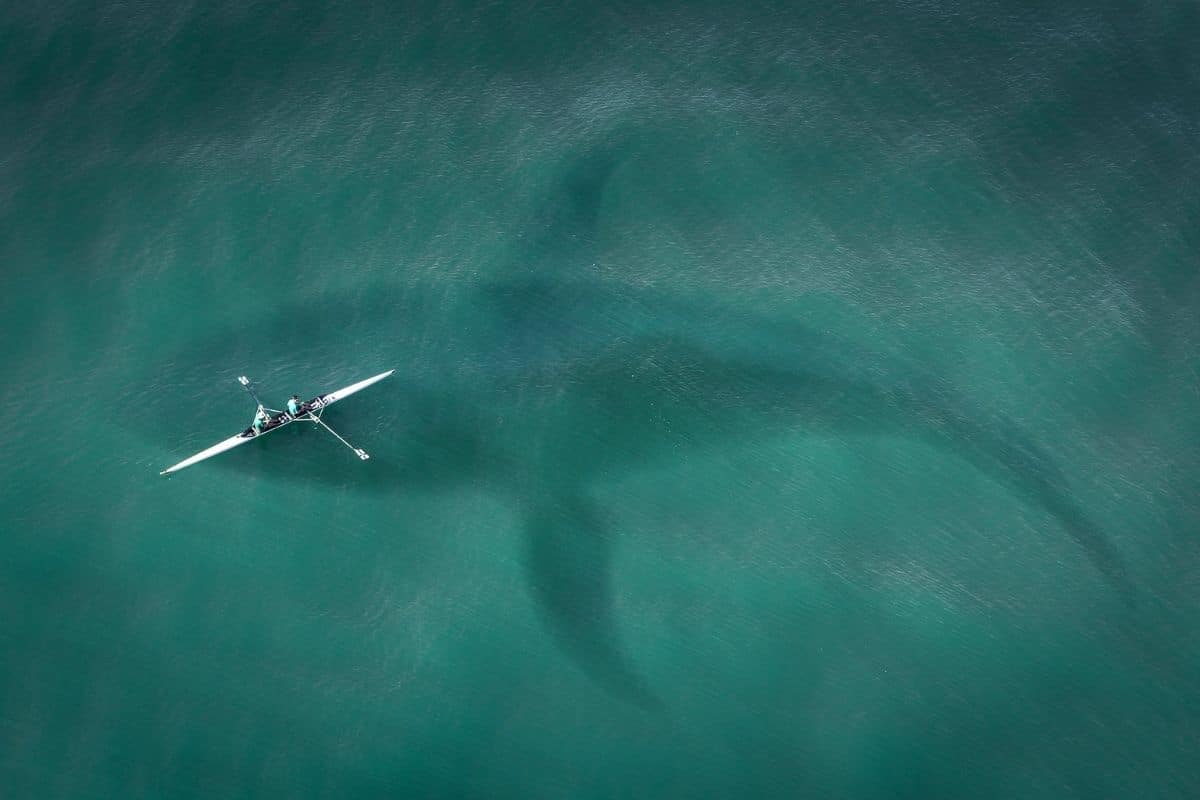
All previously proposed body shapes of the giant shark must be relegated to the realm of speculation.
Millions of years ago, a powerful and feared prehistoric predator dominated the oceans. We’re talking about megalodon: a giant shark that went extinct about 3.6 million years ago. In the meantime, much has been said and written about this shark. The beast even got a face in the 2018 action-thriller ‘The Meg’. But to what extent are we supposed to believe all this? A new study offers a sobering perspective.
Found fossils
Many fossil remains of megalodon have unfortunately not survived the test of time. All we have are some triangular teeth and a few vertebrae. As a result, we know that the shark must have been gigantic: the teeth are as big as a real human hand.

Paleobiologist Kenshu Shimada holds a tooth of an extinct megalodon. Image: DePaul University/Jeff Carrion
The beast appeals to the imagination of both the public and scientists. Something that doesn’t come as much of a surprise to researcher Kenshu Shimada, a professor of paleobiology at DePaul University in Chicago and research associate at the Sternberg Museum in Kansas. “I think it’s because there is no modern shark that compares to megalodon based purely on the extraordinarily gigantic teeth that have been preserved,” he told IPS. Scientias.nl†
Shadow
At the same time, the lack of megalodon fossils means we’re actually little sure about the shadow that swam the seas millions of years ago. “We know that megalodon was an unusually gigantic carnivorous shark, which most certainly fed on marine mammals,” said Shimada. The shark is therefore usually depicted as a super large, monstrous shark. “However, the biology remains surprisingly poorly understood due to the fact that the species is mainly known only for its teeth,” said Shimada.
Did you know that megalodon also swam in the Netherlands? The terrifying shark was found in all seas on Earth. At the time this shark lived (between 15 and 3.6 million years ago), the Netherlands was still almost completely under water. Megalodon was also able to survive in these shallow waters. Teeth of megalodon testify to this, which were found in Zeeland and South Limburg, among other places.
In previous studies, scientists have made a frantic attempt to estimate megalodon’s body size from those teeth. Something that is not so easy yet. “There are several methods of determining how big megalodon was,” explains Shimada. “These are usually based on the teeth found compared to the size of modern sharks, such as the great white shark. Megalodon is generally thought to have been at least 15 meters and possibly 20 meters in size.”
White shark
But know for sure, scientists don’t. And a new study makes megalodon’s appearance even more uncertain. Many models assume that megalodon resembled today’s great white shark, one of the ocean’s fiercest predators and the largest predatory shark alive today. The white shark belongs to the shark family Lamnidae (porbeagle sharks). The sharks belonging to this family are partly warm-blooded, which means that they can raise their temperature above the ambient temperature. This makes them active predators. Megalodon did not belong to the porbeagle family, but scientists suspect that it was closely related and also partly warm-blooded.
Appearance
So based on this close relationship, scientists usually turn to the porbeagle sharks when trying to give megalodon a face. But to what extent is that reliable? In the new study, Shimada and his colleagues found out. They compared the appearance of the warm-blooded sharks of the porbeagle family with the characteristics of the cold-blooded mako shark family, to which megalodon actually belongs. It leads to a sobering conclusion. Because the study strongly indicates that there is no relationship between thermophysiology and body shape in shortfin mako sharks. In short, even though Megalodon may have been warm-blooded, it wouldn’t have suddenly made it look like, say, the great white shark from another shark family.
Disappointing
It means that we actually know next to nothing about what megalodon looked like. And so we’ll have to go back to the drawing board. We simply do not currently have the scientific resources to support or disprove the accuracy of previously proposed megalodon body shapes. These should therefore be regarded as pure speculation for the time being. “This may seem disappointing and a step backwards in science,” said Shimada. “But the new study is a good demonstration of how science works. Personally, the fact that we still don’t have an answer motivates me to do more research into deciphering the biology of the extinct shark.”
More fossils
The only thing that could actually lift a corner of the veil is if scientists stumble upon more fossilized megalodon remains. “In order to infer body shape, we need remnants other than teeth and vertebrae,” Shimada says. “Even a fragmentary skeleton, for example just a skull or fins, would greatly help us understand the biology of the prehistoric shark.”
The actual appearance of the giant shark thus remains puzzling for the time being. But Shimada doesn’t see that as a negative thing. “This lingering mystery makes paleontology, the study of prehistoric life, a fascinating and exciting field of science,” he argues. In addition, he is optimistic and thinks that Megalodon has not taken all his secrets with him to his grave. “I’m hopeful it’s only a matter of time before we find more fossils,” he concludes.
Source material:
† Latest study reveals no one still knows what the Megalodon really looked like” – Taylor & Francis Group
Interview with Kenshu Shimada
Image at the top of this article: Sarah Richter via Pixabay